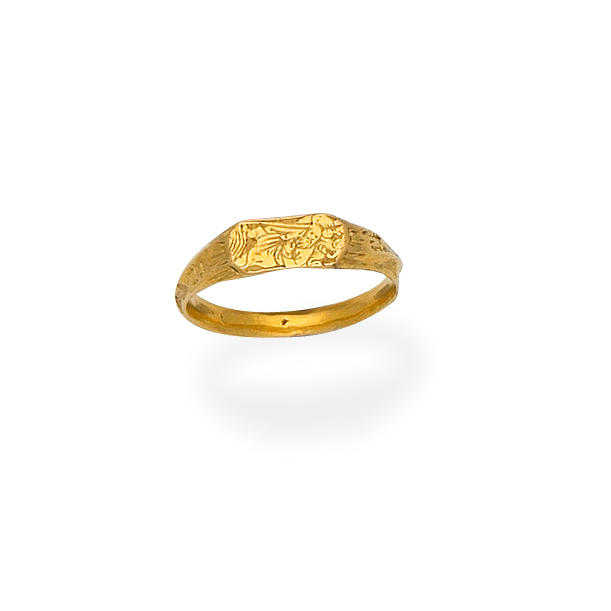MEDIEVAL GOLD ST CHRISTOPHER ICONOGRAPHIC RING 15th century AD or later A D-section gold hoop with facetted edges, octagonal bezel with incised image of St. Christopher with staff wading in water and bearing Christ with radiating beams to the rear. 14 grams, 25mm overall, 21.24mm internal diameter (approximate size British X, USA 11 1/2, Europe 26.29, Japan 25) (1"). Condition Very fine condition. A very large wearable size. Provenance From an old Suffolk collection; formed 1990-2000. Literature Cf. Chadour, A.B. Rings. The Alice and Louis Koch Collection, volume I, Leeds, 1994, items 588, 589 for type. Footnotes Iconographic rings depicting saints or images of Christ were a widespread form of personal devotion in fifteenth century England, and were often exchanged as love tokens, particularly around New Year. They rarely bear inscriptions but are often decorated with one, two or, at most, three, panels engraved with images of popular saints such as Christopher or Barbara, as well as Christ or the Virgin Mary. These rings combine devotion and romantic commitment in a form of perpetual daily devotion that had both private and public components. St Christopher was a popular saint in the medieval period due to his being the bearer of Christ across a dangerous river; as such he was seen as the protector of travellers. Travel in medieval times was slow, unpleasant, and dangerous. At any time, someone could break a wheel, a person or animal could get sick, a storm could arrive suddenly, or brigands could attack, as well as the possibility of supernatural danger in the form of demons. Pilgrimage formed an important part of medieval life, with people travelling vast distances to perform a form of penance in seeking help with a problem. By having Christopher on a ring such as this, they were hoping the saint would protect them on the long and hazardous journeys.
MEDIEVAL GOLD ST CHRISTOPHER ICONOGRAPHIC RING 15th century AD or later A D-section gold hoop with facetted edges, octagonal bezel with incised image of St. Christopher with staff wading in water and bearing Christ with radiating beams to the rear. 14 grams, 25mm overall, 21.24mm internal diameter (approximate size British X, USA 11 1/2, Europe 26.29, Japan 25) (1"). Condition Very fine condition. A very large wearable size. Provenance From an old Suffolk collection; formed 1990-2000. Literature Cf. Chadour, A.B. Rings. The Alice and Louis Koch Collection, volume I, Leeds, 1994, items 588, 589 for type. Footnotes Iconographic rings depicting saints or images of Christ were a widespread form of personal devotion in fifteenth century England, and were often exchanged as love tokens, particularly around New Year. They rarely bear inscriptions but are often decorated with one, two or, at most, three, panels engraved with images of popular saints such as Christopher or Barbara, as well as Christ or the Virgin Mary. These rings combine devotion and romantic commitment in a form of perpetual daily devotion that had both private and public components. St Christopher was a popular saint in the medieval period due to his being the bearer of Christ across a dangerous river; as such he was seen as the protector of travellers. Travel in medieval times was slow, unpleasant, and dangerous. At any time, someone could break a wheel, a person or animal could get sick, a storm could arrive suddenly, or brigands could attack, as well as the possibility of supernatural danger in the form of demons. Pilgrimage formed an important part of medieval life, with people travelling vast distances to perform a form of penance in seeking help with a problem. By having Christopher on a ring such as this, they were hoping the saint would protect them on the long and hazardous journeys.
.jpg)
.jpg)
.jpg)
.jpg)

.jpg)
.jpg)
.jpg)


.jpg)


.jpg)
Testen Sie LotSearch und seine Premium-Features 7 Tage - ohne Kosten!
Lassen Sie sich automatisch über neue Objekte in kommenden Auktionen benachrichtigen.
Suchauftrag anlegen